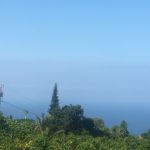As a result of the recent Kīlauea eruption that began on September 29,2021, vog conditions and sulfur dioxide (SO₂) air levels are increasing and fluctuating in various areas of the state. Although eruptive activity is within Hawaiʻi Volcanoes National Park, changing wind conditions have created intermittent air quality problems in areas west of the summit such as Pahala, Nāʻālehu, and Ocean View as well as Hilo and East Hawai‘i.
Poor air quality and increased levels of SO₂ may cause problems with respiratory health, especially in sensitive individuals. Hawai‘i residents and visitors are advised to be prepared and aware of the surrounding conditions.
The following precautionary measures are advised in the event of vog:
- Reduce outdoor activities that cause heavy breathing. Avoiding outdoor activity and exercise during vog conditions can reduce exposure and minimize health risks. This is especially important for sensitive groups such as children, the elderly, and individuals with pre-existing respiratory conditions including asthma, bronchitis, emphysema, and chronic lung and heart disease.
- Stay indoors and close windows and doors. If an air conditioner is used, set it to recirculate.
- If you need to move out of an impacted area, turn on the car’s air conditioner and set it to recirculate.
- Always keep medications on hand and readily available.
- Daily prescribed medications for respiratory illnesses should be taken on schedule and may provide protection from the effects of sulfur dioxide.
- Remember that face coverings and masks used to prevent the spread of COVID-19 do not provide protection from SO₂ or vog.
- Contact a doctor as soon as possible if any health problems develop.
- Do not smoke and avoid second-hand smoke.
- Drink plenty of fluids to avoid dehydration.
- Have family emergency plans prepared and ready.
- Heed warnings by county and state emergency management officials.
Visitors to the Hawaiʻi Volcanoes National Park should note that rockfalls and explosions can produce ash composed of volcanic glass and rock fragments. These ashfalls currently represent a minor hazard, but dustings of ash at areas around the Kīlauea summit are possible.
The Hawai‘i Department of Health (DOH) is encouraging residents and visitors to utilize the following resources that provide complete, clear and current information on the health effects of vog, how to protect yourself, vog and wind forecasts, air quality, changing conditions, and advice for visitors:
- Hawaiʻi Interagency Vog Information Dashboard at www.ivhhn.org/vog/ for the most comprehensive and up-to-date online information on vog and SO₂ from volcanic activity.
